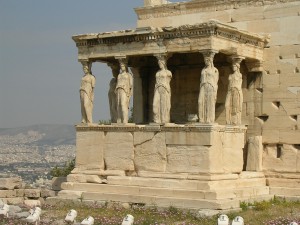Field Museum 
 Erechtheion, Acropolis, Athens
Erechtheion, Acropolis, Athens
The architecture of both the Field Museum and the Museum of Science & Industry are not only neoclassical in design but directly reference the Erechtheion on the Acropolis in Athens. The Erechtheion is a sacred space just opposite the Parthenon adorned with a porch featuring caryatids, statues of women supporting the roof in place of columns. The final designs of both Chicago museums include prominent displays of caryatids sculpted by Henry Herig.
The exterior sculptural groups visually assert that women belong in the new public spaces (e.g., the World’s Fair, museums, parks) and encouraged women to utilize these urban oases. But, the white classical figures incorporated into stark monumental neoclassical architecture in Chicago might also have expressed, knowingly or implicitly, a less inclusive political message. These buildings proclaimed Chicago’s notable place in the development of Western Civilization. But would black and indigenous parts of the region’s population see themselves in that story of cultural accomplishment as easily as the new waves of immigrants from Europe?
For more about the relation of Greek architecture and the caryatids to the design of the Field Museum .
Read about caryatids at the Museum of Science and Industry.
Knowledge of the caryatids circulated in the US in the 19th century largely through artwork, engineering studies and tales produced by Western travelers to this region after Greek War of Independence (1821-30). Consider American artist Sanford Robinson Gifford’s 1880 painting, “Ruins of The Parthenon,” now in the National Gallery in Washington D.C.. It focuses on the Parthenon but also includes the porch of the Erectheion at the far right of his composition (a zoom in feature is active). The tower visible in the painting in front of the Erechtheion was demolished by authorities of the developing Greek nation state eager to destroy signs of the long years of Ottoman occupation and to visibly proclaim claim a continuous Greek national identity for its population.
The caryatids are among the most arresting pieces on exhibit in the Acropolis Museum in Athens. The exhibit demonstrates the capacity of preservationists and archaeologists to recover evidence of the bright colors originally painted on the figures and to recreate the original polychromatic appearance of the figures in a digital reproduction. Read more about the Acropolis caryatids at the Acropolis Museum in Athens. Also, this New York Times article is about the technology used in the restoration of the caryatids in the Acropolis Museum and includes a link to a short video.
(S.S.M.)




